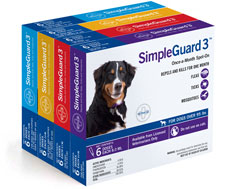
Fast-acting protection against fleas, ticks, mosquitoes, lice, mites and sand flies.
Description
No matter where you live, vectors (parasites) may infect your dog. It only takes one bite. That's why it's important to use a fast-acting vectoricide like Vethical SimpleGuard® 3. It kills and repels vectors. Because it kills through contact, parasites don't even have to bite to die.
- Repels and kills adult fleas, ticks, mosquitoes, lice, mites and sand flies.
- Kills on contact; parasites do not have to bite or feed to die.
- Repellent action helps reduce the risk of vectors spreading disease to your dog.
- Quick onset of activity killing adult fleas in 2 hours.
- Prevents the development of all immature flea stages: eggs, larvae and pupae.
- Protects for 1 full month.
- Remains effective after bathing and swimming.
- Protection for puppies as young as 7 weeks of age.
Application
Vethical SimpleGuard 3 uses a unique, patented applicator that features an elongated tip to make it easy to apply to a dog's skin through the hair coat. The rounded tip minimizes risk of skin abrasions. The contoured applicator is easy to use, eliminates spillage and splashing, and has been clinically tested to ensure accurate dosing. With the one-piece applicator, there is no need to use scissors to open or remove a cap, making application fast and efficient and, at the same time, minimizing the potential of a choking hazard.
One-click design makes application a snap
You'll appreciate our easy-to-open, easy-to-apply applicator. The one-click design means there's no cap to remove or cut off. You simply push the two disks together and apply as directed. Our applicator is so unique, it's patented.
You'll love it too
The Vethical SimpleGuard 3 applicator is a big hit with veterinarians, veterinary technicians and dog owners across the country. Here's why:
- Easy does it: The rounded tip minimizes risk of skin abrasions.
- Hits the target: Elongated tip makes it easy to reach your dog's skin through the hair coat.
- One-click design: Push the two disks together to puncture the seal—no cap to remove or cut off.
- No drips & No splash: Nothing comes out until you squeeze the tube, so no messes.
- Precision instrument: Tested to ensure accurate dosing. Allows you to apply the full dose.
How to apply Vethical SimpleGuard 3 properly
Watch this video demonstration or follow the step by step instructions below:
How to apply:
- USE ONLY ON DOGS. DO NOT USE ON CATS OR OTHER ANIMALS.
- Remove applicator from package.
- The dog should be standing or in a comfortable position for easy application.
- Holding the applicator tube upright pointing away from face, place thumb and index finger around the applicator tip under the large disk. With other hand, grasp the stem of applicator tip above smaller disk. Press down firmly on small disk until both disks meet, piercing the seal. See illustration.
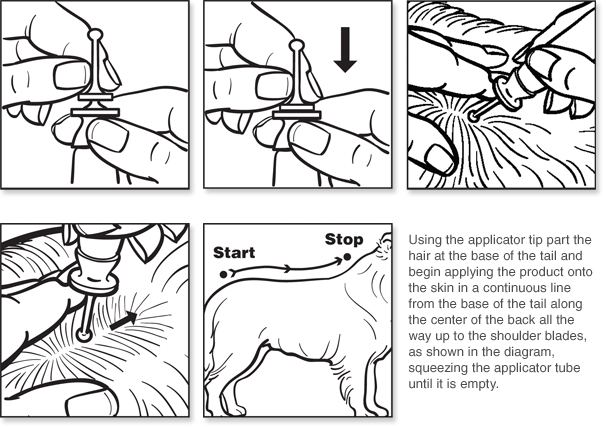
- Discard empty applicator tube as outlined in Storage and Disposal.
- Repeat every month or as recommended by your veterinarian but not more often than every 30 days.
- For optimum treatment, control and prevention of adult and immature fleas, ticks, mosquitoes, lice, mites (excluding mange mites) and biting and sand flies year-round treatment is recommended.
Storage and Disposal:
- Do not contaminate water, food or feed by storage and disposal.
- Storage: Store in a cool, dry place. Protect from freezing.
- Disposal: : If empty, do not reuse the container. Place in trash or offer for recycling if available. If partially filled, call your local solid waste agency for disposal instructions. Never place unused products down any indoor or outdoor drain.
Action
Fleas: More trouble than you can see
If your dog has fleas, it's very important to realize that the adult fleas you see make up a very small percentage of the entire flea problem. Under ideal conditions, a pair of fleas can produce millions of descendants in one year, and each new generation can grow from egg to adult in only 21 days. Since fleas have such an incredibly rapid rate of reproduction, it's critical to prevent the development of all flea stages - from the flea eggs, larvae and pupae to adult.
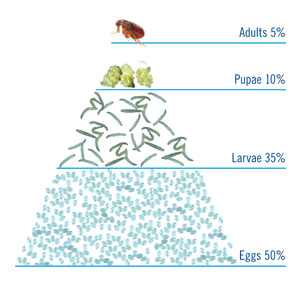
| Vector | Diseases | Symptoms |
|---|---|---|
 |
Anemia (Especially in young pets) | Pale Gums, Weakness |
| Tapeworm disease | Irritability, Rough Coat, Mild Diarrhea, Weight Loss | |
| Flea Allergy Dermatitis (FAD) | Inflammation, Rash, Severe Itching, Hair Loss |
The need for new chemistry
Nature is constantly shifting, and vectors tend to adapt in order to survive. Over time, fleas can develop resistance to existing chemistry, which makes some active ingredients less effective in protecting pets from infestation and infection.
Vethical SimpleGuard 3 products are based on a brand new compound called dinotefuran. After years of development, numerous studies and veterinary clinics across the United States have shown that Vethical SimpleGuard 3 products kill fleas quickly, without a noticeable decline in effectiveness between applications.
Complete flea protection
Vethical SimpleGuard 3 products, used once a month, every month of the year, effectively prevent all stages of the flea life cycle by killing adult fleas, flea larvae and early pupae. Breaking the life cycle may help reduce the risk of flea allergy dermatitis and other serious diseases. It is imperative that all pets in the household be treated to ensure complete flea protection.
Ticks: We take vector-borne diseases very seriously
Parasites that transmit disease are also called vectors. When an infected vector, such as a tick or mosquito, bites your pet, it could make your pet very sick. Heartworm and Lyme disease are just two examples of diseases spread by vectors.
Diseases transmitted by Ticks:
| Vector | Diseases | Symptoms |
|---|---|---|
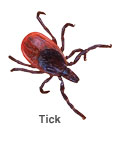 |
Lyme disease | Swollen Joints, Fever, Anorexia, Lethargy, Lameness |
| Rocky Mountain spotted fever | Fever, Anorexia, Muscle and Joint Pain, Trouble Breathing, Neurological Signs, Swelling of Face and/or Legs | |
| Ehrlichiosis/Anaplasmosis | Fever, Fatigue, Swollen Lymph Nodes, Edema, Depression, Loss of Stamina, Stiffness, Lethargy | |
| Babesiosis | Lethargy, Weakness, Pale Gums, Weight Loss, Emaciation, Coughing, Labored Breathing, Fever | |
| Tick Paralysis | Gradual Paralysis (usually starts in hind legs) | |
| Hepatozoonosis | Fever, Anorexia, Weight Loss, Bloody Diarrhea, Muscle Pain, Progressive Debilitation |
Mosquitoes: More than an annoyance
Diseases transmitted by Mosquitoes:
| Vector | Diseases | Symptoms |
|---|---|---|
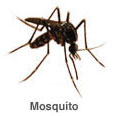 |
Heartworm disease | Coughing, Difficulty Breathing, Weight Loss, Kidney or Liver Failure in Severe Cases |
| West Nile virus | Fever, Disoriented, Lethargy, Head Tilt, Weakness, Ataxia |
Other vectors controlled by SimpleGuard 3:
| Vector | Diseases | Symptoms |
|---|---|---|
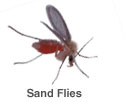 |
Leishmanisis | Fever, Hair Loss (especially around eyes), Weight Loss, Skin Sores, Nosebleeds, Lameness, Diarrhea and Liver or Renal Failure |
 |
Severe dermatitis | Severe Itching, Scruffy Dry Coat (with bald patches), Shedding, Crusting and Scaling |
| Tapeworm disease | Rough Coat, Weight Loss | |
| Anemia | Pale Gums, Weakness | |
 |
Profuse Scaling Dermatitis (Cheyletiella) | Severe Itching and Dandruff Rash (walking dandruff) |
FAQs

Due to their unique physiology and inability to metabolize certain compounds this product must not be used on cats. If applied to a cat, or ingested by a cat that actively grooms a recently treated dog, this product may have serious harmful effects. If this occurs, contact your veterinarian immediately.
SimpleGuard® 3, Once-a-month, Topical Treatment: Frequently Asked Questions
This summary contains important information about SimpleGuard. You should read this information before you start giving your dog SimpleGuard and review it each time the prescription is refilled. This sheet is provided only as a summary and does not take the place of instructions from your veterinarian. Talk to your veterinarian if you do not understand any of this information or if you want to know more about SimpleGuard.
How do I open the tube?
A: The applicator disks should be pushed together and left that way in preparation for application to your dog. Only the colored tip and cap should be grasped while pushing the disks together. If pressure is applied to the tube, or if the disks are pulled apart, product may leak out from the tube.
My dog appears to be itching after applying SimpleGuard 3; is this normal?
Yes, this can happen. SimpleGuard 3 has been designed to spread rapidly over your dog’s skin, to provide fast protection to all areas of your dog. This, in addition to the unique molecules contained in SimpleGuard 3, can result in a transient itching sensation experienced by some dogs as the product moves across the skin. Follow the application method shown above to enhance movement and reduce sensation. If your dog does experience itching, try a simple distraction such as playing ball or going for a walk until the SimpleGuard 3 is dry. For the small percentage of dogs that do experience itching, most only experience it the first time SimpleGuard 3 is applied, so SimpleGuard 3 can be applied again with confidence in the future.
Is SimpleGuard 3 safe to use on my dog if I have a cat in my home?
Yes, SimpleGuard 3 is safe to use in cat/dog households – BUT SHOULD NEVER BE APPLIED DIRECTLY ON CATS. You simply need to keep your dog and cat separated for at least 24 hours, after applying SimpleGuard 3 to your dog, until the product is dry. After it is dry, your dog and cat can be as close as they want; there is no risk of intoxication via lying near each other or grooming each other. However, SimpleGuard 3 can be toxic if a cat ingests the liquid product. If this occurs, please call your veterinarian immediately.
Can I bathe my dog before or after I apply SimpleGuard 3?
Yes, your pet just needs to be completely dry before applying SimpleGuard 3 and the product needs to dry completely before bathing. You do not need to wait 48 hours before or after application. The shampoo you choose is very important, too. Do not use detergent dish soap or detergent shampoos; this will remove the SimpleGuard 3 from your pet’s skin and hair, resulting in loss of protection for your pet. Remember, if your pet is receiving therapeutic shampoos and rinses from your veterinarian for other skin diseases, they may affect the duration of action of SimpleGuard 3. Your veterinarian can talk to you about ways to use SimpleGuard 3 in these situations.
Why does my pet’s coat appear “oily” or “wet” after application?
SimpleGuard 3 contains a bioadhesive and other agents (often called inert ingredients to stabilize the product and help it spread across your pet’s skin) and continues to kill parasites for 30 days. In some cases, the product may wick up the hair. When this occurs, a sheen may be noted on the dog’s fur after the product has dried. The effective components of SimpleGuard 3 have already moved to other parts of the pet’s body to do their job. A simple brushing of the coat will make this disappear.
What does repellency mean?
Repellency has different effects depending on whether the parasite is able to fly or not. For biting flies and mosquitoes, repellency means that the insects hover near the pet, sense the product, and are repelled away without landing on your pet. For fleas and ticks, repellency works differently. Fleas and ticks, once in the process of getting on your dog, can’t “change their minds.” However, once there, they are affected by SimpleGuard 3 and don’t want to stay on your dog, so they are repelled away from the skin. These fleas and ticks will die shortly after they leave your pet’s hair coat.
Why do I see fleas (or ticks) on my pet after applying SimpleGuard 3?
Don’t be alarmed by the visibility of fleas or ticks on your pet! It may simply mean your pet already had fleas and SimpleGuard 3 is working! SimpleGuard 3 repels and kills fleas and ticks, driving them from the skin surface, so they don’t bite your pet. Because the fleas and ticks find no “safe haven” at the skin surface, they scurry from the skin and on to the top of the hair coat, trying to get away from the product. Since these fleas and ticks have been exposed to the effects of SimpleGuard 3, most, if not all of them will not be able to bite your pet and cause irritation or transmit diseases.
My dog had fleas (or ticks) and then I started using SimpleGuard 3, but I am still seeing them. Is SimpleGuard 3 not working?
If you have seen fleas (or ticks) on your dog, then you most likely already have an environmental infestation. This means that thousands of fleas (or ticks) in various stages of development are in your house (or yard). With severe infestations, you may notice more fleas at 10-21 days after applying SimpleGuard 3. This is expected and due to the emergence of adult fleas from the immature forms in the home environment. It will take several months of continuous use for SimpleGuard 3 to affect the immature stages of the parasites in the environment. Adults will also be killed. You must also make sure that ALL the pets in your house are treated for fleas with the appropriate SimpleGuard product. Please remember not to use SimpleGuard 3 on cats. Any untreated animal can act as a source of continued infestation for the other pets. Ticks are different than fleas in how they infest the environment. Thousands of ticks can reside in small areas of nature. It is not unusual for a dog to be exposed to these huge tick burdens from a simple walk outdoors. Some species of ticks like to infest the house like fleas (for example, Brown Dog Tick). If this happens, you may need the services of a professional exterminator. You will continue to see fleas and ticks on your dog until the environmental infestation is cleared because of the repellency aspect of SimpleGuard 3. (See “repellency” description in earlier question.)
How can I prevent my dog from getting fleas and/or ticks and causing an infestation in my house?
Using SimpleGuard 3 is a great way to prevent an infestation and protect your dog from being bitten by fleas and ticks. Most organizations like the Companion Animal Parasite Council (CAPC), the American Animal Hospital Association and the American Society of Veterinary Parasitologists recommend year-round use of flea and tick preventives to help control fleas, ticks, lice, biting and sand flies, and mites (excluding mange mites), to help decrease the incidences of vector-borne diseases.



